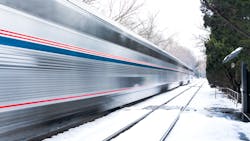FRA publishes rule establishing minimum on-time standards between Amtrak and host railroads
The Federal Railroad Administration (FRA) published a final rule Nov. 16 that sets up metrics and a minimum standard to measure the performance and quality of service of Amtrak intercity operations.
The final rule is more than 12 years in the making since FRA and Amtrak were mandated by the Passenger Rail Investment and Improvement Act of 2008 to jointly develop metrics and minimum standards for measuring passenger train performance and service quality.
The final rule follows a Notice of Proposed Rulemaking in March and FRA says the final rule accounted for “a lot of voices and perspectives.”
“We’ve listened and worked diligently to create the best solution for all,” said FRA Administrator Ronald Batory.
What does the rule do?
A brief explainer: Amtrak owns about three percent of the track it operates over, mostly in the Northeast Corridor. Most of the track Amtrak operates over is owned by freight railroads (host railroads). Amtrak pays a fee to use these tracks and the tracks are maintained and dispatched by the host railroads.
The final rule requires Amtrak and its host railroads to certify Amtrak schedules and sets an on-time performance minimum standard of 80 percent for any two consecutive calendar quarters. A train arriving within 15 minutes of its published arrival time is considered on time. Other metrics that FRA defines in the final rule include ridership, train delays, station performance and host running time.
“This final rule is a major accomplishment for this administration and a huge victory for the traveling public,” Batory said. “When I personally met with the leaders of Amtrak and the nation’s largest freight railroads earlier this year, I impressed upon them the need for the traveling public to have reliable passenger rail service, and the administration’s final rule reflects a commitment to improving Amtrak’s performance in the modern-day freight rail environment.”
Amtrak compiles an annual report card for the six Class 1 freight railroads and assigns a letter grade based on the number of delays caused to Amtrak trains. In 2019, the average grade for all host railroads was a “C” with Canadian Pacific receiving an “A,” CSX, BNSF and Union Pacific receiving sliding “B” scale grades, Canadian National receiving a “D” and Norfolk Southern receiving an “F.”
The 2019 Report Card found all 15 long-distance trains failed to achieve an 80 percent on time standard, while 19 of 27 state-supported trains failed to achieve the standard.
As part of the economic analysis of the final rule, FRA stated Amtrak could see reduced labor and fuel costs, as well as reduced expenses related to passenger inconvenience because of improved on time performance.
The rule also calls for quarterly reports to be published on the performance and service quality of Amtrak’s trains.
FRA explains the final rule’s singular on-time performance standard gives customers, Amtrak, the host railroads and other stakeholders a method to objectively gauge Amtrak trains.
“Everyone relying on one standard means that when problems arise, we can all speak the same language to work toward a common goal,” said Batory.
In reaction to the rule being published, Amtrak issued a statement that notes the railroad believes its customers deserve to arrive on time.
“This is a victory for Amtrak customers and for anyone who believes people and communities across the country deserve a world-class passenger rail network with schedules that you can count on. For too long, many freight railroads have put their cargo ahead of our passengers – in direct opposition to the law. This rule will help Amtrak enforce its rights when they are violated, in order to get you to your destination on schedule,” said the railroad.
As of press time, there was not an available statement from the Association of American Railroads, which represents the freight rail industry.
The rule goes into effect on Dec. 16, 2020.
About the Author

Mischa Wanek-Libman
Group Editorial Director
Mischa Wanek-Libman is director of communications with Transdev North America. She has more than 20 years of experience working in the transportation industry covering construction projects, engineering challenges, transit and rail operations and best practices.
Wanek-Libman has held top editorial positions at freight rail and public transportation business-to-business publications including as editor-in-chief and editorial director of Mass Transit from 2018-2024. She has been recognized for editorial excellence through her individual work, as well as for collaborative content.
She is an active member of the American Public Transportation Association's Marketing and Communications Committee and served 14 years as a Board Observer on the National Railroad Construction and Maintenance Association (NRC) Board of Directors.
She is a graduate of Drake University in Des Moines, Iowa, where she earned a Bachelor of Arts degree in Journalism and Mass Communication.
